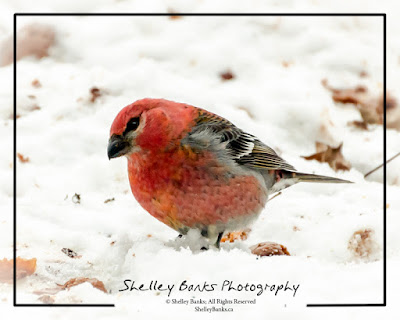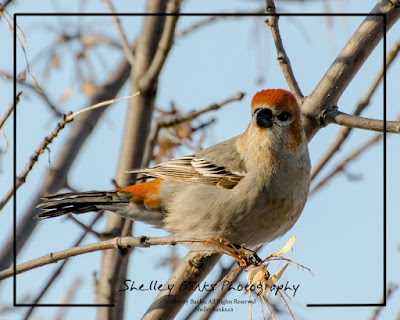 |
| Male Pine Grosbeak, taking a break from feeding on crabapples. © SB |
of the most beautiful birds I saw this season: A male Pine Grosbeak feeding on frozen crabapples in an old orchard.
We'd been watching the flock for days, hoping to see a mature male in all his scarlet glory, but for days, he eluded us. (Was there really only one? We saw many females and/or immature males, with their far less vibrant colouring.) Finally, one evening, he appeared; word quickly spread, and the cameras came out.
These birds, as the Audubon field guide says, are "often absurdly tame." I took the pictures of the red Pine Grosbeak through a gap in a windbreak wall of spruce trees, and yes, it saw me, but appeared barely curious. A quick glance, then a return to what mattered: eating the fruit at his feet.
The female Pine Grosbeaks tend to be more beige or gray overall, with golden highlight feathers on the head and back... Immature males, the same, except that some may also sport brighter orange feathers. I'm not sure I can tell the difference, though I'd tend to call the brighter birds, males. (Birds.Cornell.edu has some comparative shots, though the author of that page was also less than confident in the distinctions.)
These are large birds of the boreal forest — significantly bigger than the House Finches that frequent my backyard bird feeders. All About Birds calls them the rarest of winter finches, and says they periodically make winter irruptions into southern Canada and northern United States. I understand that the colouring of the males may vary through shades of pink, but ours was most definitely scarlet.
 |
| I'm going to guess that this one is a female Pine Grosbeak - though it could equally be an immature male. ©SB |
 |
| Male Pine Grosbeak in the crapapple, at right; immature male or female on the ground, at left. ©SB |
 |
| I'd call this an immature male, making the transition to full scarlet feathers. Not only are his head and back bright, but there are a few scarlet feathers already dotting his chest. ©SB |
What are these? Pine Grosbeaks — Durbec des sapins.
Location: Near Muenster, Saskatchewan, Canada.
Photo dates: Top three: February 17 - 19, 2016; bottom: November 14, 2014.
Photo dates: Top three: February 17 - 19, 2016; bottom: November 14, 2014.
~~~~~

No comments:
Post a Comment